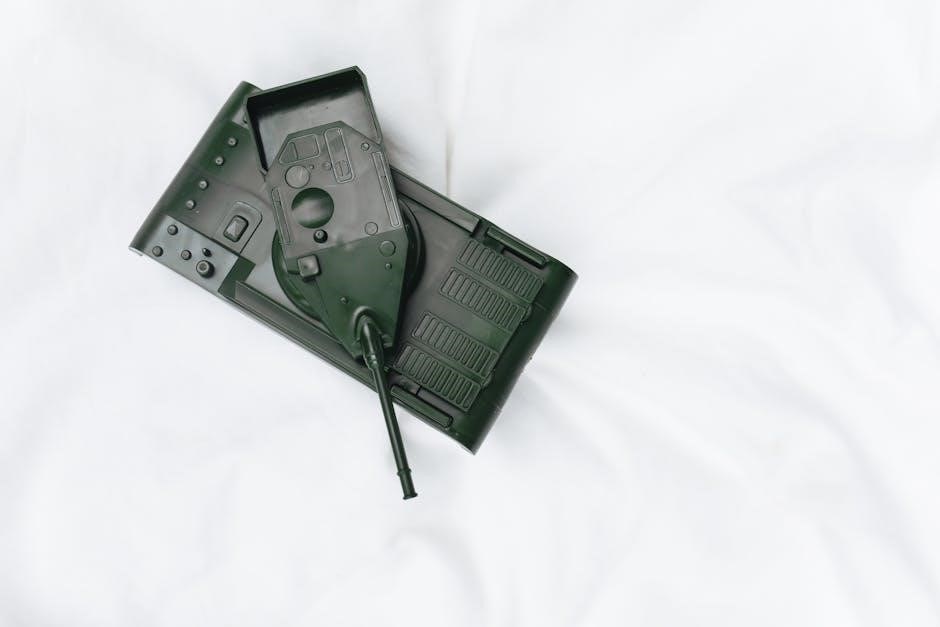raid fogger instructions
Raid Foggers are effective for eliminating pests indoors. However, their use requires careful attention to instructions and safety guidelines. This guide provides essential steps for safe application.
1.1 Importance of Following Instructions
Following Raid Fogger instructions is crucial for safety and effectiveness. Misuse can lead to health risks, including chemical exposure and respiratory issues. Proper application ensures pests are eliminated while minimizing hazards. Ignoring guidelines may result in incomplete treatment or lingering odors. Always adhere to dosage and ventilation recommendations to protect yourself, pets, and the environment. Correct usage also prevents unnecessary exposure and potential legal or environmental consequences.
1.2 Safety Precautions
Essential safety precautions include evacuating people and pets before use. Cover fish aquariums to prevent chemical contamination. Avoid using foggers in small, confined spaces. Always read the label carefully and follow ventilation guidelines. Open windows and doors after the recommended waiting period to ensure safe re-entry. Never re-enter the premises until the area is well-ventilated and free of residual odors. Proper precautions protect health and ensure effective pest control without unnecessary risks.

Safety Measures Before Using Raid Fogger
Before using Raid Fogger, remove pets and people, cover fish aquariums, and prepare the room. These steps ensure safety and effectiveness of the treatment.
2.1 Removing Pets and People
Ensure all pets and people leave the premises before activating Raid Fogger. This prevents exposure to toxic fumes. Keep them away until the recommended waiting period ends. Always prioritize health and safety by following these precautions diligently.
2.2 Covering Fish Aquariums

Cover fish aquariums thoroughly before using Raid Fogger. Turn off the aquarium, cover it tightly with a lid or plastic wrap, and ensure it is completely sealed. This prevents toxic fumes from entering the water and harming aquatic life. Protecting fish is crucial, as fogger chemicals can be deadly to them. Always prioritize their safety during pest control treatments.
2.3 Preparing the Room
Before using Raid Fogger, thoroughly prepare the room. Open all cabinets, drawers, and closets to ensure the fog reaches all areas. Remove any food, toys, and bedding. Cover surfaces with newspaper or plastic to protect them from residue. Move furniture away from walls if possible. This ensures even distribution of the fog and maximizes effectiveness. Proper preparation is key for successful pest control and safety.

Step-by-Step Instructions for Using Raid Fogger

Activate the fogger in the center of the room, ensuring it dispenses evenly. Vacate the premises immediately after activation to avoid exposure to harmful chemicals.
3.1 Reading the Label Carefully

Reading the label carefully is crucial for safe and effective use. It provides detailed instructions, recommended dosage, and essential safety precautions. Understand the product’s ingredients, application methods, and any environmental warnings. Ignoring label instructions can lead to health risks or ineffective pest control. Always follow the guidelines to ensure proper treatment and minimize exposure to harmful chemicals. The label also specifies the appropriate areas for use and precautions to protect pets and aquariums.
3.2 Setting Up the Fogger
Setting up the fogger correctly ensures even distribution of the product. Place the fogger on a stable, covered surface in the center of the room. Remove any protective tabs and press the actuator firmly until it clicks. Ensure all windows and doors are closed to contain the fog. Cover floors, furniture, and surfaces with newspapers or plastic sheets to prevent residue buildup. Activating the fogger in a well-prepared space maximizes effectiveness and safety. Proper setup is key to achieving desired results.
3.3 Activating the Fogger
Press the actuator firmly until it clicks to release the fog. Ensure all windows and doors are closed to trap the fog inside. Immediately leave the room and secure the area to prevent re-entry. The fogger will automatically discharge its contents, filling the space evenly. Allow the product to work for the recommended time, usually 2-3 hours, before ventilating. Activating correctly ensures thorough pest elimination and safety for occupants.
3.4 Vacating the Premises

After activating the fogger, leave the room or building immediately. Ensure all people, pets, and fish are removed to avoid exposure. Do not re-enter the premises until the recommended waiting period, usually 2-3 hours, has elapsed. This allows the fog to dissipate and ensures safety. Upon returning, open windows and doors for proper ventilation. Always follow the label’s instructions for the exact time required before re-entry to minimize health risks and ensure effectiveness.

Post-Application Instructions
After using Raid Fogger, wait the recommended time before re-entry. Open windows and doors for ventilation. Check for lingering odors and ensure the area is safe.
4.1 Waiting Period Before Re-Entry
After activating the Raid Fogger, vacate the premises and wait at least 2 hours before re-entry. This allows the fog to dissipate and ensures safety. Open windows, vents, and doors for 2 hours to ventilate thoroughly. If a strong odor persists, extend ventilation time. Always follow the product’s label instructions for the recommended waiting period to avoid exposure to residual chemicals.
4.2 Ventilating the Room
After the waiting period, thoroughly ventilate the room by opening all windows, doors, and vents. Use fans to circulate air and speed up the removal of residual fog. Continue ventilating for at least 2 hours or until no odor remains. Proper ventilation ensures the space is safe for re-entry. Avoid using foggers in small, confined areas, as this can lead to uneven distribution and prolonged exposure to chemicals.
4.3 Checking for Residual Odor
After ventilating, inspect the room for any lingering chemical smell. If the odor persists, extend the ventilation period or use air purifiers. Strong residual odors may indicate incomplete airing or overuse of the fogger. Ensure all areas, including closets and cabinets, are odor-free before occupying the space; If the smell remains severe, consider consulting a professional for further assistance. Proper ventilation is crucial for safe re-entry.

Best Practices for Effective Use
Always follow label instructions, calculate dosage accurately, and avoid overuse to ensure safety and effectiveness. Never use foggers in small, confined spaces without proper ventilation.
5.1 Calculating the Correct Dosage
Calculating the correct dosage is crucial for safe and effective use of Raid Foggers. Always refer to the product label for specific instructions. The label will provide guidelines based on the size of the area you are treating. Using too much can lead to lingering odors and potential health risks, while too little may not fully eliminate pests. Proper measurement ensures optimal results without overexposure to chemicals. This step helps maintain both efficacy and safety.
5.2 Avoiding Overuse
Avoiding overuse is essential to prevent unnecessary exposure to chemicals and potential health risks. Follow the label instructions carefully to ensure the correct amount of fogger is used for the treated area. Overuse can lead to lingering odors and increased toxicity, making the space unsafe for re-entry. It can also contribute to pesticide resistance in pests, reducing the product’s long-term effectiveness. Always adhere to the recommended dosage to maintain safety and efficiency.
5.3 Not Using in Small Spaces
Using Raid Foggers in small, confined areas is highly discouraged due to the risk of excessive chemical concentration. Spaces like closets, cabinets, or rooms smaller than 5×5 feet can lead to dangerous fumes buildup. This increases health risks for people and pets. Always use foggers in well-ventilated, larger areas as specified on the label to ensure safe and effective pest control without compromising indoor air quality or safety.

Common Mistakes to Avoid
Avoiding mistakes ensures safe and effective fogger use. Common errors include ignoring ventilation guidelines, using foggers in confined spaces, and not following label instructions, which can pose health risks.
6.1 Ignoring Ventilation Guidelines
Ignoring ventilation guidelines is a critical mistake. Proper airflow helps dissipate the fogger’s active ingredients, reducing lingering odors and potential health risks. Failing to ventilate can trap harmful residues, leading to prolonged exposure. Always open windows and doors post-application as instructed to ensure safety and effectiveness. This step is crucial for minimizing toxicity and ensuring the treatment’s success without compromising indoor air quality.
6.2 Using Foggers in Confined Areas
Using foggers in confined areas, such as closets or small rooms, is highly risky. These spaces lack sufficient airflow, leading to pesticide buildup. This can create hazardous conditions, increasing the likelihood of inhalation and exposure. Always adhere to the label’s guidelines regarding minimum room size and ventilation requirements. Using foggers in improperly sized areas can compromise safety and effectiveness, potentially causing health issues for people and pets. Proper space selection is crucial for safe application.
6.3 Not Following Label Instructions
Failing to follow the label instructions for Raid Foggers is a critical mistake. Ignoring dosage guidelines or preparation steps can lead to ineffective pest control, health risks, and legal consequences. Misuse may result in overexposure to chemicals, causing respiratory issues or other health problems. Additionally, improper application can contaminate surfaces or harm unintended targets, including pets and wildlife. Always read and adhere to the instructions carefully to ensure safety and efficacy. Proper use is essential for desired results and environmental protection.
Troubleshooting and Additional Tips
If lingering odors remain after ventilation, consider using fans or air purifiers. Ensure complete coverage by opening cabinets and doors before activation. For persistent pest issues, combine foggers with other products; Always check for residual effects and reapply if necessary. Proper preparation and adherence to instructions are key to achieving optimal results and minimizing potential hazards.
7.1 Dealing with Lingering Smells
Lingering odors after using Raid Fogger can be addressed by extending ventilation periods. Open windows and doors for at least two hours or longer if needed. Use fans to circulate air and consider employing air purifiers to neutralize remaining smells. Wash any surfaces or fabrics that may have come into contact with the fogger. Ensure proper room preparation and avoid using foggers in smaller spaces than recommended. Always follow label instructions for optimal results and to minimize residual odors.
7.2 Ensuring Complete Coverage
To ensure complete coverage, remove pets and cover aquariums before use. Prepare the room by opening cabinets and doors. Place the fogger in the center on a covered stand. Avoid small spaces and follow label instructions for dosage. Activate and leave the area immediately. After the waiting period, ventilate thoroughly to ensure even distribution and effectiveness. Proper preparation and adherence to guidelines maximize coverage and pest elimination efficiency.
7.3 Using Foggers in Combination with Other Products
Using foggers with other pesticides can enhance effectiveness but requires caution. Always follow label instructions for compatibility. Avoid flammable products and ensure proper ventilation. Combining foggers with residual sprays or baits can provide long-term control. However, never mix foggers with other chemicals indoors. Prioritize safety and consult professionals if unsure. This approach helps achieve comprehensive pest elimination while minimizing risks. Balance is key for optimal results and safety.
Environmental and Health Considerations
Raid foggers contain toxic chemicals that can harm humans, pets, and the environment. Proper disposal and usage minimize ecological impact and health risks, ensuring safer application.
8.1 Understanding Toxicity Levels
Raid foggers contain chemicals like pyrethrins and piperonyl butoxide, which can be harmful if inhaled or ingested. Prolonged exposure may cause respiratory issues or skin irritation. Pets and wildlife are particularly vulnerable to these toxins. It’s crucial to follow dosage instructions and ensure proper ventilation to minimize health risks. Incorrect usage can lead to severe environmental contamination, affecting aquatic life and soil quality. Always prioritize safety and environmental care when applying foggers.
8.2 Disposal of Used Foggers
Proper disposal of Raid foggers is essential to prevent environmental contamination. Always follow local regulations for hazardous waste disposal. Do not crush or puncture the canister, as it may still contain residual chemicals. If empty, dispose of it in a sealed container. Check with local authorities for designated drop-off locations. Never discard foggers in regular trash unless explicitly permitted. Proper disposal ensures safety for waterways, soil, and wildlife.
8.3 Impact on Pets and Wildlife
Raid foggers can be highly toxic to pets and wildlife. Prolonged exposure may lead to severe health issues or even death. Ensure all pets are removed from the premises before use. Cover aquariums securely to protect fish. Wildlife, such as birds, may also be affected if they enter treated areas. Always adhere to safety guidelines to minimize risks to animals; Keep foggers out of reach of pets and avoid use in areas where wildlife may be present.
Frequently Asked Questions
Common questions include re-entry times, usage in small spaces, and inhalation risks. Answers emphasize following label instructions and ensuring proper ventilation for safety and effectiveness.
9.1 How Long Should I Stay Out of the House?
After using Raid Fogger, stay out of the house for at least 2 hours. Once re-entering, open windows and vents for 2 hours to ensure proper ventilation. If a strong odor persists, extend the ventilation period. Always follow the product’s instructions for safe re-entry and to avoid exposure to residual chemicals. Prolonged absence may be necessary in cases of sensitivity or lingering smells.
9.2 Can I Use Foggers in Cars or Small Rooms?
Foggers should not be used in cars or small, confined spaces like closets or bathrooms. They are designed for larger areas and require proper ventilation to function safely. Using foggers in small spaces can lead to dangerous concentrations of the product, posing serious health risks. Always check the label for minimum room size requirements and avoid using foggers in vehicles or tight spaces to ensure safe and effective application.
9.3 What If I Accidentally Inhale Fog?
If you accidentally inhale fog from a Raid Fogger, move to fresh air immediately. If symptoms like dizziness, nausea, or irritation occur, seek medical attention. In severe cases, call emergency services. Do not delay seeking help, as foggers contain chemicals that can be harmful if inhaled. Follow the product’s safety guidelines to minimize exposure and ensure proper ventilation after use to avoid such incidents.
This guide provides essential steps for safe and effective Raid Fogger use. Always follow instructions to ensure safety and successful pest control.
10.1 Summary of Key Points
Using Raid Foggers effectively requires careful preparation and adherence to safety guidelines. Remove pets and people, cover aquariums, and prepare rooms thoroughly. Always read the label, follow dosage instructions, and avoid small spaces. After activation, vacate the premises and wait the recommended time before re-entry. Proper ventilation is crucial to eliminate residual odors and ensure safety. Avoid common mistakes like ignoring ventilation guidelines or using foggers in confined areas. By following these steps, you can achieve effective pest control while maintaining a safe environment.
10.2 Final Tips for Safe and Effective Use
Always follow label instructions precisely and ensure proper ventilation post-application. Avoid overuse to prevent harmful residue buildup. Never use foggers in small, enclosed spaces. After re-entry, check for lingering odors and pests. If necessary, repeat the process as directed. Stay vigilant about re-entry times to ensure safety. By prioritizing these steps, you can maximize effectiveness while minimizing risks to health and the environment.












Leave a Comment